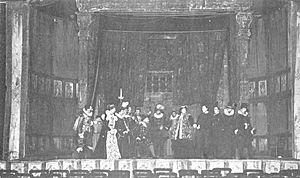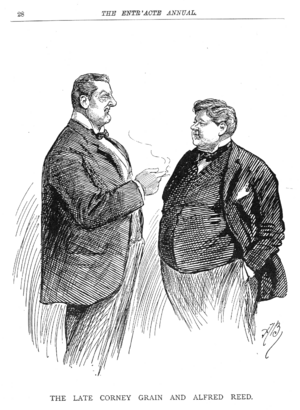St. George's Hall, London facts for kids
St. George's Hall was a famous theatre and concert hall in Langham Place, a busy area in the West End of London. It was built in 1867 and entertained people for nearly 100 years, closing in 1966. The hall was quite large, able to hold 800 to 900 people, and even up to 1,500 if you included the upper seating areas called galleries. A man named John Taylor designed the building.
For about 30 years, St. George's Hall was well-known for special shows called the German Reed Entertainments. These were often musical comedies and plays. Besides these, the hall also hosted many lectures and other musical events. After 1895, the hall changed its focus. It became a place for different kinds of shows like vaudeville (a mix of acts), plays, and even magic shows. It was also the main building for the London Academy of Music and Dramatic Art, where people learned about music and acting. At one point, it even turned into a skating rink!
In 1933, the BBC (a big TV and radio company) took over the hall. They used it as a studio to broadcast shows. However, during World War II, the building was badly damaged by bombs in March 1943. Because of this, it had to close. St. George's Hall was finally pulled down in 1966. Today, the St Georges Hotel and Henry Wood House stand where the old hall used to be.
Contents
Early Shows and German Reed Entertainments
St. George's Hall first opened on April 24, 1867, as a concert hall for the New Philharmonic Society. It was designed so it could also be used as a theatre. The very first play performed there was A Woman's Whim in December 1867.

Soon after, a man named Thomas German Reed rented the theatre. He started putting on his own shows. These included small versions of operas like The Contrabandista and The Beggar's Opera. In 1874, Thomas's wife, Priscilla German Reed, brought their famous German Reed Entertainments to St. George's Hall. Their shows were special because they used a small stage and only a piano and harmonium for music.
Thomas retired in 1871, and his son Alfred continued the shows with his mother. Later, Alfred worked with Richard Corney Grain. They kept the German Reed Entertainments going until both of them passed away in 1895.
Famous Writers and Performers
Many popular writers created shows for St. George's Hall. W. S. Gilbert, who later became very famous for his operettas with Arthur Sullivan, wrote a comedy called A Medical Man (1872) and a short opera called Eyes and No Eyes (1875) for the hall. Other writers like John Baldwin Buckstone and John Maddison Morton also wrote plays for the theatre.
Besides plays and music, the hall also hosted many lectures. For example, Gerald Massey gave talks about Christianity in 1872. Charles Voysey gave regular Sunday sermons there. Even the famous writer H. G. Wells mentioned a visit to a lecture at the hall in one of his writings. When the German Reed company wasn't using the hall, it was often rented out for other performances or events.

Many talented people performed at St. George's Hall. Fanny Holland was a big star in many of the German Reed shows. Other performers included Mr. and Mrs. German Reed, their son Alfred, and Richard Corney Grain. Leonora Braham, who became a well-known singer, made her first professional stage appearance at the hall in 1870. She performed in a show called Ages Ago. Fanny Holland performed at St. George's Hall for many years, until 1895.
Later Uses of the Hall
After the German Reed Entertainments ended in 1895, the building changed its name to the Matinee Theatre in 1897. It tried to put on "high class vaudeville" shows, which were a mix of different acts, but it wasn't very successful. After that, some German plays were shown, but the hall closed in 1904.
In 1905, a famous magician named John Nevil Maskelyne took over the hall. He made some changes and reopened it as 'St George's Hall, England's New Home of Mystery.' He started putting on his own magic shows called Maskelyne's Theatre of Mystery. The hall also became the meeting place for The Magic Circle, a group for magicians. Maskelyne and another magician named David Devant performed many magic shows there for years.
The hall was also used as a Bioscope Picture Palace, which showed early movies. It also served as the main building for the London Academy of Music and Dramatic Art, where students learned about music and acting. Later, the hall was even changed into a skating rink for a while!
BBC Studio and Final Days
In 1933, Eric Maschwitz bought St. George's Hall for the BBC. They turned it into a studio for broadcasting radio shows like vaudeville, comedy, and reviews. It opened as a BBC studio on November 25, 1933. In 1936, the BBC installed a special organ called the BBC Theatre Organ. This organ could make many different sounds for the performances.
During World War II, the hall was hit by bombs several times. It was badly damaged in September 1940, May 1941 (when the nearby Queen's Hall was destroyed), and March 1943. Because of the damage, the BBC studios had to move to the Aeolian Hall. St. George's Hall was finally torn down in 1966. Today, the land where it stood, along with the Queen's Hall site, is now home to the St George's Hotel and Henry Wood House.



